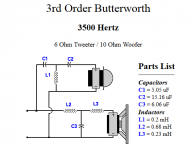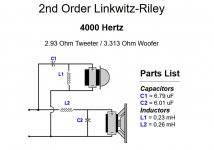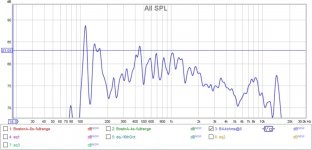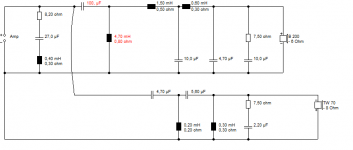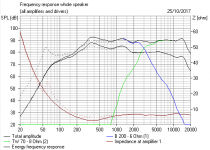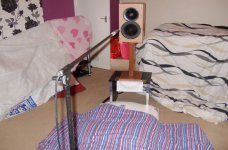I am trying to design a crossover using a subwoofer, full range and tweeter. The subwoofer has its own amplifier with a Y connection which I can run up to 200hz using the plate amp. Looking at the specs of the full range and tweeter, consulting the comments here and there, 2-way crossover at anywhere from 2k to 4k looks ideal. I bought the parts viz. caps, inductors for a 2nd order LR two way crossed at 4k using the diyaudioandvideo.com crossover calculator. I realize afterwards that I also need to cut 200hz and below on the full range.
My question is what do I need to cut(high pass) the full range speaker at around 200hz and below? Given that the 2way crossover at 4k will be there, will another high pass crossover at 200hz be possible on the same speaker?
Will appreciate any help.
Kaytee
My question is what do I need to cut(high pass) the full range speaker at around 200hz and below? Given that the 2way crossover at 4k will be there, will another high pass crossover at 200hz be possible on the same speaker?
Will appreciate any help.
Kaytee
Hi Kaytata,
You are really making a 3-way system, so normally the midrange would be band-limited. With an active sub this is less of a requirement. This is more like a satellite + sub configuration.
Having an active HP filter (before the satellite amplifier) give you maximum dynamic range. It reduces the the voltage it needs to produce, as well as the excursion on the midrange.
Having a passive HP filter reduces the current, but your amp will still need to produce the full voltage swing of the bass.
Having no HP filter at all is still possible, but the downside is more interaction with the sub.
Best,
E
You are really making a 3-way system, so normally the midrange would be band-limited. With an active sub this is less of a requirement. This is more like a satellite + sub configuration.
Having an active HP filter (before the satellite amplifier) give you maximum dynamic range. It reduces the the voltage it needs to produce, as well as the excursion on the midrange.
Having a passive HP filter reduces the current, but your amp will still need to produce the full voltage swing of the bass.
Having no HP filter at all is still possible, but the downside is more interaction with the sub.
Best,
E
I am trying to . .
My question is what do I need to cut(high pass) the full range speaker at around 200hz and below? Given that the 2way crossover at 4k will be there, will another high pass crossover at 200hz be possible on the same speaker?
Will appreciate any help.
Kaytee
Hello!
I use this:
Speaker Crossover Calculators by V-Cap
Try a 82u or 100uF capacitor before the mid (for 8 Ohm)
Regards,
S
Crossing a mid-woofer to a sub can be done in several ways:
1. with an appropriate plate amp having also a HP filter for the "satellites"
2. with passive elements (coils, caps, resistors)
3. using the box effect
Option 2 is difficult because the elements for a sub 200Hz crossover are costly and moreover interact badly with the FR. If your plate amp doesn't provide the HP filter, you are left with option 3: an appropriate closed box can give you a nice 2nd order rolloff.
Ralf
1. with an appropriate plate amp having also a HP filter for the "satellites"
2. with passive elements (coils, caps, resistors)
3. using the box effect
Option 2 is difficult because the elements for a sub 200Hz crossover are costly and moreover interact badly with the FR. If your plate amp doesn't provide the HP filter, you are left with option 3: an appropriate closed box can give you a nice 2nd order rolloff.
Ralf
Advice depends on circumstances. Perhaps you should describe the exact drivers employed here and the enclosures.
Otherwise it's like saying to a mechanic, my unknown car won't start. Why? 😀
Crossover calculators are based on speakers behaving like 6 ohm resistors. But they don't. They have inductance.
Your calculator is simply giving butterworth values in an impedance corrected world. This is a better one which is more precisely defined: 2-Way Crossover Calculator / Designer
But you must correct impedance to get this right. And add any necessary bafflestep: mh-audio.nl - Home
Hence I come up with these values below for the two-way part with some passive 3.9R/1mH bafflestep. For the sub to two-way transition, you probably need some sort of 100uF/4.7mH second order filter on the (unknown) fullrange. But kid yourself not, you will need some resistors to adjust level to flat. And phase alignment will also depend on the drivers.
Otherwise it's like saying to a mechanic, my unknown car won't start. Why? 😀
Crossover calculators are based on speakers behaving like 6 ohm resistors. But they don't. They have inductance.
Your calculator is simply giving butterworth values in an impedance corrected world. This is a better one which is more precisely defined: 2-Way Crossover Calculator / Designer
But you must correct impedance to get this right. And add any necessary bafflestep: mh-audio.nl - Home
Hence I come up with these values below for the two-way part with some passive 3.9R/1mH bafflestep. For the sub to two-way transition, you probably need some sort of 100uF/4.7mH second order filter on the (unknown) fullrange. But kid yourself not, you will need some resistors to adjust level to flat. And phase alignment will also depend on the drivers.
Attachments
Thanks for the quick response and expertise – ericsquires, horvaths, giralfino, system7.
You’re right System7. I should describe my drivers and enclosures.
Subwoofers – Two Eminence Alpha 15a(8 ohm) in h-frame(MJK) driven by Amphony micrFidelity 200 amp.
http://www.eminence.com/pdf/Alpha_15A.pdf
Full range – Boston Acoustics full range 4 ohm in a 16 by 20 inch open baffle, link below:
Boston Acoustics - HQ48413P - 8" Hi-Q Fullrange Driver - 4 Ohms - Pair
Tweeter – Peerless TL25SN silk dome which I will attached to the open baffle plate of the full range given above.
Peerless Fabrikkerne (I) Ltd - TL25SN - 25mm Silk DomeTweeter
I am trying to use my 8w SET Chinese el34 amp to drive the full range and tweeter.
The BA-full range does not have the frequency response on the site. I have minidsp’s UMIK microphone. I am attaching a response sweep I did at listening position, 7 feet with REW.
The calculated crossover components using diyaudiovideo pic for crossing at 4khz is also enclosed.
Will appreciate any advise.
As you will see in the response graph of the BA full range, there is around 10 db hump at 114hz. Because of that problem, it would be essential to cut the bass from 200hz.
Looking forward to your comments and expertise.
You’re right System7. I should describe my drivers and enclosures.
Subwoofers – Two Eminence Alpha 15a(8 ohm) in h-frame(MJK) driven by Amphony micrFidelity 200 amp.
http://www.eminence.com/pdf/Alpha_15A.pdf
Full range – Boston Acoustics full range 4 ohm in a 16 by 20 inch open baffle, link below:
Boston Acoustics - HQ48413P - 8" Hi-Q Fullrange Driver - 4 Ohms - Pair
Tweeter – Peerless TL25SN silk dome which I will attached to the open baffle plate of the full range given above.
Peerless Fabrikkerne (I) Ltd - TL25SN - 25mm Silk DomeTweeter
I am trying to use my 8w SET Chinese el34 amp to drive the full range and tweeter.
The BA-full range does not have the frequency response on the site. I have minidsp’s UMIK microphone. I am attaching a response sweep I did at listening position, 7 feet with REW.
The calculated crossover components using diyaudiovideo pic for crossing at 4khz is also enclosed.
Will appreciate any advise.
As you will see in the response graph of the BA full range, there is around 10 db hump at 114hz. Because of that problem, it would be essential to cut the bass from 200hz.
Looking forward to your comments and expertise.
Sorry, I forgot to mention one important detail. I am using a minidsp 2x4 to low pass the subwoofer(e alphas) so am looking to cut the bass only on the full range side so that the two do not interfere/interact in the bass region.
I don't think any of this is going to work.
I did a simulation of an Visaton B200 8" fullrange with tweeter a while back.
B 200 - 6 Ohm
I needed quite a complex filter to get it working well. And adding a 100uF is hopeless (the dotted response), and a 100uF with 4.7mH is overly low impedance, IMO (The solid response).
I think Troels said he needed electronic filters on the bass and the midbass.
OB9
OBL-15
Your 4 ohm drivers don't make anything easier.
I did a simulation of an Visaton B200 8" fullrange with tweeter a while back.
B 200 - 6 Ohm
I needed quite a complex filter to get it working well. And adding a 100uF is hopeless (the dotted response), and a 100uF with 4.7mH is overly low impedance, IMO (The solid response).
I think Troels said he needed electronic filters on the bass and the midbass.
OB9
OBL-15
Your 4 ohm drivers don't make anything easier.
Attachments
Thanks Steve@system. If you don't mind would like to pester you a little more. I am a beginner as you can imagine. So,
1. Will minidsp 2x4 be considered electronic crossover? I do have that. Only problem I got is when I use it for the BA driver, I lost volume level due to input of 2vrms and output of 0.9vrms(my guestimate).
2. I do have the 8 ohm version of the BA Driver if that will help.
Boston Acoustics - HQ48414P - 8" Hi-Q Fullrange Driver - 8 Ohms - Pair
3. What in your opinion will be a viable solution if there are any? Or do i look elsewhere?
1. Will minidsp 2x4 be considered electronic crossover? I do have that. Only problem I got is when I use it for the BA driver, I lost volume level due to input of 2vrms and output of 0.9vrms(my guestimate).
2. I do have the 8 ohm version of the BA Driver if that will help.
Boston Acoustics - HQ48414P - 8" Hi-Q Fullrange Driver - 8 Ohms - Pair
3. What in your opinion will be a viable solution if there are any? Or do i look elsewhere?
I must be getting old. I don't use equipment anything like this! 😱
miniDSP in a BOX : miniDSP 2x4
The World's Smallest Audio Amplifier: microFidelity 200
MiniDSP looks like it will do the job here, with the appropriate "2 way advanced 21" plug in for $10. That ought to split the bass from the midbass at around 200Hz on steep as you like filters. I was assuming you have two speakers here with two stereo amplifiers because you will need some level adjustment at some point. Unless the DSP has independent level adjustment.
The Class D amp looks a bit puny for bass duties, since it can't be more than 36W judging from the 36V/1A power supply. But see how it goes.
Back to these drivers:
8 inch fullrange with DCR around 8R: Boston Acoustics - HQ48414P - 8" Hi-Q Fullrange Driver - 8 Ohms - Pair
1" horn loaded 4 ohm soft dome, DCR 3R: Peerless Fabrikkerne (I) Ltd - TL25SN - 25mm Silk DomeTweeter
The 15" Eminence Alpha 15 is familiar enough: Speaker Detail | Eminence Speaker
Open baffle is so out of my experience, that I can't help much except to suggest reading a few designs:
http://www.troelsgravesen.dk/Diy_Loudspeaker_Projects.htm#Open_baffle_constructions
The impedance correction for the Boston 8" must be around 9.2R plus a 10uF: http://www.mh-audio.nl/bdl.asp#calc
Open baffle bafflestep is something I know little about, but must kick in around 300Hz on 16" baffle.
A simple two way second order crossover done with an online calculator must allow for an 8 ohm bass and a 3 ohm DCR tweeter. Impedance correction on the Boston Acoustics looks good at 9.2R and 10uF.
Now, me, I would take those calculated values and impedance correction into a simulator, to see how it looks. http://www.visaton.de/en/literature/software/downloads/index.html
At this point, a frequency response plot at least is useful.
miniDSP in a BOX : miniDSP 2x4
The World's Smallest Audio Amplifier: microFidelity 200
MiniDSP looks like it will do the job here, with the appropriate "2 way advanced 21" plug in for $10. That ought to split the bass from the midbass at around 200Hz on steep as you like filters. I was assuming you have two speakers here with two stereo amplifiers because you will need some level adjustment at some point. Unless the DSP has independent level adjustment.
The Class D amp looks a bit puny for bass duties, since it can't be more than 36W judging from the 36V/1A power supply. But see how it goes.
Back to these drivers:
8 inch fullrange with DCR around 8R: Boston Acoustics - HQ48414P - 8" Hi-Q Fullrange Driver - 8 Ohms - Pair
1" horn loaded 4 ohm soft dome, DCR 3R: Peerless Fabrikkerne (I) Ltd - TL25SN - 25mm Silk DomeTweeter
The 15" Eminence Alpha 15 is familiar enough: Speaker Detail | Eminence Speaker
Open baffle is so out of my experience, that I can't help much except to suggest reading a few designs:
http://www.troelsgravesen.dk/Diy_Loudspeaker_Projects.htm#Open_baffle_constructions
The impedance correction for the Boston 8" must be around 9.2R plus a 10uF: http://www.mh-audio.nl/bdl.asp#calc
Open baffle bafflestep is something I know little about, but must kick in around 300Hz on 16" baffle.
A simple two way second order crossover done with an online calculator must allow for an 8 ohm bass and a 3 ohm DCR tweeter. Impedance correction on the Boston Acoustics looks good at 9.2R and 10uF.
Now, me, I would take those calculated values and impedance correction into a simulator, to see how it looks. http://www.visaton.de/en/literature/software/downloads/index.html
At this point, a frequency response plot at least is useful.
Last edited:
Thanks Steve.
I'll try your suggested correction and simulate it as soon as components arrive.
A couple of queries though:
1. For the crossover calculator, where is the best way to take the resistance from - the nominal eg. 4 ohm, the re eg. 7.293 or at the crossover point?
2. For analysis, do I measure 1m from the speaker, or from the listening position?
Regards & Cheers.
I'll try your suggested correction and simulate it as soon as components arrive.
A couple of queries though:
1. For the crossover calculator, where is the best way to take the resistance from - the nominal eg. 4 ohm, the re eg. 7.293 or at the crossover point?
2. For analysis, do I measure 1m from the speaker, or from the listening position?
Regards & Cheers.
It's the DCR quoted in the specifications. Or you just do a simple resistance measurement with a multimeter.
Don't ask me about measuring. I don't do it. Maybe somebody else can advise. Like fatmarley aka Matt, below.
This is a hugely difficult undertaking IMO. Even the SET amp complicates things for flat impedance. I can only think you need to get the two-way working right, then splice the Eminence sub-woofer on with the electronic crossover.
Don't ask me about measuring. I don't do it. Maybe somebody else can advise. Like fatmarley aka Matt, below.
This is a hugely difficult undertaking IMO. Even the SET amp complicates things for flat impedance. I can only think you need to get the two-way working right, then splice the Eminence sub-woofer on with the electronic crossover.
Attachments
Steve@system7,
I have made a 1st order Butterworth with 14.65uf and 0.35mH, combined with your suggested impedance eq circuit with 9.2R and 10uf in parallel. Sounds very very good. Thanks for the help.
I also chance upon the raspberry pi3 + Allo Kali & Piano 2.1 combo for source and dac which is not that expensive(around 130usd). I have never heard a more articulate sound (though I haven't heard that many). Brings my system right up there.
Cheers
I have made a 1st order Butterworth with 14.65uf and 0.35mH, combined with your suggested impedance eq circuit with 9.2R and 10uf in parallel. Sounds very very good. Thanks for the help.
I also chance upon the raspberry pi3 + Allo Kali & Piano 2.1 combo for source and dac which is not that expensive(around 130usd). I have never heard a more articulate sound (though I haven't heard that many). Brings my system right up there.
Cheers
- Status
- Not open for further replies.
- Home
- Loudspeakers
- Multi-Way
- Need Help with Crossover
